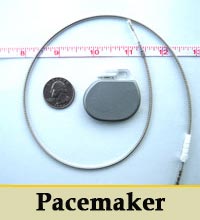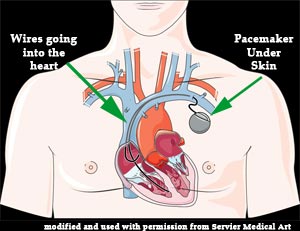 Slow heart rates (called “bradycardias”) can be seen commonly in the elderly without prior known heart disease, but can also be seen in patients with heart attacks or episodic fast rhythms such as atrial fibrillation. Symptoms can include lightheadedness, fatigue and even passing out (fainting) for no other clear reason. These symptoms can occur suddenly and infrequently or slowly develop over time and be present all the time.
Slow heart rates (called “bradycardias”) can be seen commonly in the elderly without prior known heart disease, but can also be seen in patients with heart attacks or episodic fast rhythms such as atrial fibrillation. Symptoms can include lightheadedness, fatigue and even passing out (fainting) for no other clear reason. These symptoms can occur suddenly and infrequently or slowly develop over time and be present all the time.
Fortunately, there is definitive therapy for this problem in the form of a pacemaker. A pacemaker is a small device that is placed under the skin near the collarbone with a wire placed through the a vein leading the right ventricle of the heart. This device is “set” for a minimum heart rate usually between 50 and 60 beats per minute. As long as the patient maintains a heart rate above the minimum rate, the pacemaker does nothing but monitor the heart. If the patient has any heart rate below this rate, the pacemaker will stimulate the heart to beat at the “set” rate. Depending on how often the pacemaker is needed to stimulate the heart, the pacemaker can last from 7-10 years. To replace the battery, another surgery is needed.
 The operation to place the pacemaker typically takes 30-60minutes. It is performed under local anesthesia with mild to moderate sedation but not general anesthesia. (General anesthesia will increase the risk for complications with the procedure). Typically the only discomfort felt is during the injection of local anesthesia at the start of the procedure. A small incision is made under the clavicle and a wire is placed through the vein below the collarbone into the heart (right ventricle). The small generator is then placed under the skin and attached to the wire. You will spend the night in the hospital the night after the procedure on a cardiac unit. A chest x-ray will be performed the following day and typically the patient is discharged to follow-up with our Device Clinic as well as with your cardiologist.
The operation to place the pacemaker typically takes 30-60minutes. It is performed under local anesthesia with mild to moderate sedation but not general anesthesia. (General anesthesia will increase the risk for complications with the procedure). Typically the only discomfort felt is during the injection of local anesthesia at the start of the procedure. A small incision is made under the clavicle and a wire is placed through the vein below the collarbone into the heart (right ventricle). The small generator is then placed under the skin and attached to the wire. You will spend the night in the hospital the night after the procedure on a cardiac unit. A chest x-ray will be performed the following day and typically the patient is discharged to follow-up with our Device Clinic as well as with your cardiologist.
What to Expect Before the Procedure:
- Nothing to eat after the midnight before the procedure.
-
- You may take your pills with small sips of water.
- Diabetes pills should be held and if you take insulin, ask your physician how the dose should be adjusted.
- If you take Coumadin, aspirin or Plavix, please ask your cardiologist if these should be withheld before the procedure.
- You may bring a CD of your favorite music to help you relax.
What to Expect After the Procedure:
- There may be soreness at the incision site and possibly some swelling and bruising.
- The dressing should be left in place for 3 days.
- You should not take a shower for at least 3 or 4 days and definitely not bathe or swim for several weeks.
- You should try to limit large motions of the affected arm to avoid pulling out one of the wires before it has fully healed.
- Ask your cardiologist when you can drive.
- Problems to report to us after the procedure would be excessive pain, a discharge, hiccups, twitching chest muscles, palpitations or fainting, or fever.
- Follow up in the Device Clinic will be arranged for approximately one week to check the wound and evaluate the pacemaker or defibrillator function. There will not be any external stitches to remove, although occasionally the cardiologist may use staples which will require removal. You will be shown how we can communicate and reprogram the devices through a special computer and we will show you how we can perform monthly checks of the device over the phone.
- With a pacemaker in place you will have to take certain precautions. At the airport you should show them a pacemaker ID card and avoid going through the security gate which would set off the alarm because of the metal in the pacemaker. It used to be true that patients should avoid microwaves but that is not the case anymore. Cell phones may be used but it might be best to use the ear on the side opposite your pacemaker. Devices with strong electromagnetic fields such as engines, major appliances and so forth should probably be kept at least 12 inches away from the pacemaker. Ask our staff if you have any specific questions.
Complications:
Possible complications of the surgery are infection, collapse of a lung, perforation of the heart and excessive bleeding. Your cardiologist is trained in managing these potential complications.
Our hope in recommending pacemakers is to have our patients live a long time with a good quality of life.
For more information about Pacemakers, click here.
